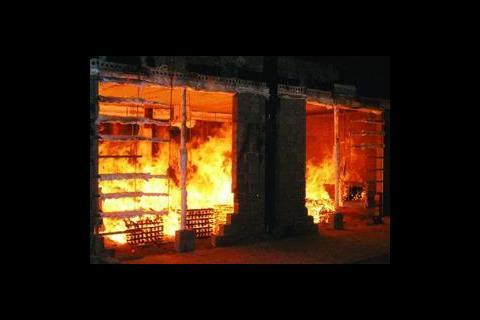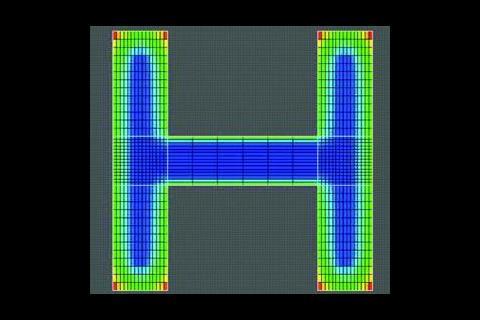The structural Eurocodes, which are in the process of conversion from pre-standards to full EN standards, make provision for the use of 'advanced calculation models' for the analysis of structures in fire.
Background
These methods are not specifically defined in the standards, but as far as thermal response is concerned it is stated that the methods shall be 'based on the acknowledged principles and assumptions of heat transfer'. Thus there are, in principle, no restrictions on methods used or area of application and cfd-based techniques, which are general in nature, provide an attractive option. This flexibility in approach and application has important implications in building design, with attendant potential benefits and dangers.
In terms of the benefits, the use of calculation methods can provide an alternative to purely test-based methods for demonstrating fire resistance compliance. The generality of the methods can also free a designer from the some of the limitations imposed by prescriptive approaches. Thus, large spaces of arbitrary complexity can in principle be analysed.
When testing is not undertaken there are dangers in adopting model predictions which are not underpinned by real test data. In fact, the importance of validation is emphasised in the structural Eurocodes, and a requirement of the use of advanced calculation models is that 'a verification of the accuracy … shall be made on the basis of relevant test results'.
Though this latter requirement is quite onerous in the case of real buildings, the potential advantages in using such approaches are sufficient that the methods are now finding application in the design of real buildings. Some of the practical issues associated with use of such modelling tools are considered in more detail.
CFD-linked thermal modelling
CFD models have been applied to simple smoke movement problems for many years and are relatively well-validated for this application. But many also permit computation of combustion giving the designer access to information on the fire development and the evolution of the heating conditions in an arbitrary space. This means that thermal performance of structural components within that space and those forming part of the enclosure boundaries can be modelled on the basis of the predicted fire conditions, rather than a prescribed time-temperature curve.
However, prediction of the thermal performance of structural components is a significant challenge as the heat transfer to and within the components of interest must be accurately modelled. In fundamental terms, this is not difficult, simply requiring the solution of the energy equation within the solid phase and determining the conditions at the gas-solid interface by the technique of 'conjugate heat transfer'. In practice, a number of factors conspire to make this a rather tricky procedure.
If the same numerical grid is used within the solid phase as the gas phase, ie a structured grid, resolution within the structural components will usually be insufficient, as the cfd grid cells defined for the gas phase in a typical building scenario are typically greater in size than the whole of the cross-sectional area of the member of interest.
Furthermore, the members of interest would often have detailed geometries, with characteristic dimensions perhaps 10 or 100 times smaller than the member size in cross-section, eg an I-beam. Thus, alternative approaches are required which allow finer meshes within the solid.
One possibility for overcoming this problem is to perform the solid phase-calculations using an independent code which has its own (finer) mesh, eg a finite-element code. This is not easy due to the requirement for thermal coupling of the gas and solid phases, which cannot be guaranteed by performing post-processed calculations for the solid.
Another possibility is to use a multi-block approach, where the overall domain is divided into component blocks which are coupled along boundaries. The problem with this is that a lot of unnecessary additional cells can be introduced into the gas-phase calculation.
With either of the above approaches, the boundary coupling is in any case compromised if the cfd code is not providing sufficient resolution of the heating conditions. In order to fully overcome these problems, a fully unstructured code must be used, where there is full flexibility on the mesh definition. However, codes exploiting this type of model are not particularly well developed for fire applications.
A further challenge arises from the fact that thermal gradients are very steep within the solid when the materials are insulating in nature, eg in fire protection materials. To accurately describe the heat transfer it is necessary to be able to resolve the thermal wave from the surface, often requiring mesh spacing of millimetre size. Under these conditions, the penalties for not correctly resolving the heat transfer are quite severe, with very large errors introduced if the cells are not sufficiently small. These would be conservative in terms of surface temperatures, but if accurate answers cannot be achieved, the purpose of using a fire engineering solution is defeated.
Accurate description of the solid phase heat transfer depends on a sufficient knowledge of the temperature-dependent thermal properties of the relevant material. These are often poorly known, and when moisture and intumescent effects are introduced, they are also not uniquely related to temperature.
BRE has developed a user-friendly interface known as JOSEFINE to allow an engineer to setup cfd simulations including steel/composite members, with or without protection. The solid-phase heat transfer is solved by a coupled embedded-mesh solver giving about a one millimetre resolution within the components of interest.
Model development and validation
Model validation has extended to numerical and physical models (eg grid resolution and effect of soot loading) and has covered a range of test cases including a series of large scale tests on a large compartment at BRE. as illustrated here.
This work has shown the importance of focusing the right balance of computational effort on the fire model and the solid-phase model. The temperature-dependent material properties have a very significant influence on the thermal response and better data on thermal properties is still needed.
Source
Building Sustainable Design
Postscript
For more information on BRE's FRS (Fire and Risk Sciences) division call 01923 664700 or e-mail: frsenquiries@bre.co.uk. Alternatively visit: www.bre.co.uk/frs























No comments yet